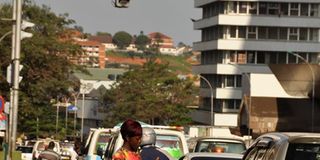Red... amber... green...: what the traffic lights mean

Cars stop at the Kampala-Entebbe road junction. PHOTO BY EDGAR R. BATTE
It is likely that you have been held at traffic lights on your way to or from work or home. Interestingly, it appears each time there is a heavy traffic, motorists tend to not only be on a short fuse but believe the stops at the lights is longer than necessary.
This is not helped by a few motorists breaking the traffic rules by forcefully driving on even when the lights indicate red—Stop.
Some view the traffic lights as a mere inconvenience.
Main reasons
But not so, according to Assistant Superintendent of Police (ASP) Justin Opus, the Officer-in-Charge Traffic at Kampala Central Police Station.
He gives three main reasons for traffic lights on the road.
First, they enable road users to safely navigate through an intersection.
Secondly, they give priority to a particular direction or mode of travel at different times.
Thirdly, they allow through large volumes of traffic with minimal delay.
How traffic lights operate
ASP Opus explains that a standard set of traffic signals consists of a traffic signal controller, vehicle detector loops and pedestrian push buttons, traffic signal lanterns, posts and electrical cables that connect all these components together.
These lights have a switchboard or controller that is built next to the pole that holds the lights.
The switchboard is housed in a room in a corner of the junction; it is here where there is a computer that processes information received from the detector loops and pedestrian push buttons and changes the signal lanterns in accordance with its programming.
“Based on the prevailing demands, the controller determines the length of the green signal for each traffic movement and controls the transition from one combination of green and red signals. Because it is powered by electricity that enables it maintain the set pattern, it operates in a stand-alone manner and the lights too operate automatically,” he says.
The vehicle loop detectors and pedestrian push buttons are mechanisms that motorists and pedestrians use to make the controllers notice and change the signal to give them right of way.
This is from the wires laid under the road leading up to the stop line at the intersection.
“When the controller detects that a vehicle is waiting to proceed through the intersection, it changes the signal. Just like with the pedestrian light, when the push button is pressed, the controller knows that a pedestrian is waiting to cross,” Opus clarifies.
The traffic signal lanterns communicate to the road users when to go and when to stop.
Officers and lights
But in Kampala, there is a unique situation. Traffic officers are always present at the intersections, and at times direct traffic contrary to what the traffic lights are showing.
“Lights are just signals that are set to operate in a particular way that is so different from how a human being thinks,” Opus explains, quoting Traffic Act section 5(a) that allows a traffic officer to use his or her discretion considering the prevailing situation or traffic flow.
An officer takes precedence over the lights in certain situations. For instance, when there is more traffic uring the morning hours when people are heading to work and leaving town in the evening traffic.
In this case, a traffic officer at a particular junction can use his or her sense of judgment depending on the traffic flow.
ASP Opus also denies the “accusations” of traffic officers causing traffic jam. An officer’s task is only to monitor and guide the traffic flow.
They also handle bad drivers. He cautions people to be respectful and patient while on the road since every person uses it for different reasons.
Punishment of violation
Drivers who violate the traffic rules are termed as bad or reckless drivers since the red light or signal does not switch abruptly.
The amber light usually displays to warn the motorists that their time of moving is over. If the driver insists on moving, he or she is bound to meet with another car ahead from another direction.
Such driving is carelessness and the culprits are normally charged with careless driving.
At times, they are issued with an on-spot fine called express penalty where the offender pays Shs100,000.
In other cases, depending on the officer at the scene, the offender can be charged and produced in the courts of law.
Pedestrian light
Pedestrian lights communicate the same way as the traffic lights. They use the symbolic walking green and standing red figures.
“It is only when it lights green that pedestrians can cross. In that case, the traffic lights regulating the vehicles indicate red, thus prohibiting any vehicle from crossing,” Opus adds.
When the pedestrian green light starts to flash, it is warning for the pedestrians not to cross.
That is if they have not reached the cross line. Or if they are in the road, to hurry up and cross before the vehicles take their right of way.
Colours in traffic lights
Red light. This communicates to drivers around a specific junction to stop. It helps to prevent collision of vehicles coming from other directions.
Amber (yellow) light. It warns the driver approaching the junction to stop because the signal is about to change to red. But if he/she is at the cross line, he/she should hurry and leave the junction. However, in some cases, where the amber and red lights displayed at ago, it indicates that the signal is about to change to green thus telling the road users to get ready to go through the intersection.
Green light. It allows traffic to proceed in that direction. However, it should be noted that the vehicles not headed in that direction, should stop to give way to the others.



